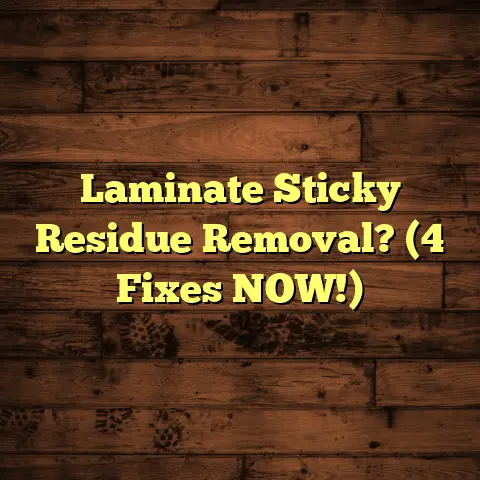Hardwood Options & Costs? (1 Day Only!)
Imagine stepping into a living room bathed in sunlight. The rich, warm tones of hardwood flooring stretch across the space. Light dances off the polished surface, highlighting the natural grain patterns. You can almost feel the story of the tree it came from.
That’s the magic of hardwood. It’s inviting, elegant, and timeless. Let’s dive into the world of hardwood flooring. We’ll explore the different types, styles, and costs. Get ready to transform your space!
Understanding Hardwood Flooring
So, what is hardwood flooring? It’s exactly what it sounds like: flooring made from a single piece of wood. This is solid hardwood.
There’s also engineered hardwood. Think of it as plywood but with a hardwood veneer on top. This construction makes it more stable, especially in areas with moisture. I’ve seen engineered floors thrive in basements where solid hardwood would buckle.
Why choose hardwood? Here are some reasons:
- Aesthetics: Nothing beats the natural beauty of wood.
- Durability: With proper care, hardwood can last for decades.
- Home Value: Hardwood floors are a major selling point. They can increase your home’s value.
Types of Hardwood Flooring
Let’s get into the nitty-gritty of wood species, grain patterns, and finishes. This is where the fun begins!
Species of Wood
The type of wood makes a HUGE difference. Each species has its own unique character and hardness. Here’s a rundown of some popular choices:
- Oak: The king of hardwoods! Oak is durable, readily available, and has a classic grain pattern. Red oak has a pinkish hue, while white oak is more neutral. On the Janka hardness scale, red oak scores around 1290, making it a solid choice for most homes.
- Maple: Known for its light color and smooth grain, maple is a modern favorite. It’s harder than oak, with a Janka rating of around 1450. This makes it a great option for high-traffic areas.
- Cherry: A luxurious choice with a rich, reddish-brown color that deepens over time. Cherry is softer than oak (Janka around 950), so it’s more prone to dents and scratches.
- Walnut: Another premium option with a dark, chocolatey color. Walnut is softer than oak (Janka around 1010) but still durable enough for many homes.
- Ash: A lighter-colored wood with a prominent grain pattern similar to oak. Ash is a good alternative to oak, with a Janka rating around 1320.
Janka Hardness Scale: This measures the resistance of wood to denting and wear. The higher the number, the harder the wood.
| Wood Species | Janka Hardness |
|---|---|
| Brazilian Walnut (Ipe) | 3684 |
| Hickory | 1820 |
| Hard Maple | 1450 |
| Red Oak | 1290 |
| White Oak | 1360 |
| American Cherry | 950 |
| American Walnut | 1010 |
| Douglas Fir | 660 |
Grain Patterns
Grain patterns are like the fingerprints of wood. They tell you how the tree grew. There are a few main types:
- Plain Sawn: The most common and affordable cut. It shows a cathedral-like pattern.
- Quarter Sawn: More stable than plain sawn. It has a straight, vertical grain.
- Rift Sawn: Similar to quarter sawn but cut at a slightly different angle. This produces an even more consistent vertical grain.
The grain pattern impacts the overall look of your floor. Plain sawn is more rustic, while quarter and rift sawn are more formal.
Finishes
The finish is the final layer of protection. It also affects the appearance of your floor. Here are some options:
- Matte: A low-sheen finish that hides scratches and dirt. It’s a great choice for busy households.
- Semi-Gloss: A classic finish that provides a nice shine without being too reflective.
- High-Gloss: A shiny finish that shows off the beauty of the wood. It requires more maintenance to keep it looking its best.
I’ve seen clients choose matte finishes for a more relaxed, modern look. Others prefer the elegance of a high-gloss finish. It’s all about personal preference.
Styles of Hardwood Flooring
Now, let’s talk about style! Hardwood flooring can fit any aesthetic, from rustic to contemporary.
Traditional vs. Contemporary
- Traditional: Think classic oak floors with a semi-gloss finish. These floors often feature narrower planks and traditional installation patterns.
- Contemporary: Embrace wider planks, matte finishes, and lighter wood species like maple. You might also see more unique installation patterns.
I recently worked on a home where we installed wide-plank, white oak floors with a matte finish. It completely transformed the space, giving it a modern, airy feel.
Width and Length Options
Plank width and length can drastically change the look of a room.
- Narrow Planks (2-4 inches): Create a more formal, traditional look.
- Wide Planks (5 inches or more): Offer a more relaxed, contemporary feel. They can also make a room feel larger.
- Long Planks (6 feet or more): Add a sense of luxury and sophistication.
- Short Planks (less than 3 feet): Can create a more rustic, informal look.
I always advise clients to consider the size of their room. Wider planks can overwhelm a small space, while narrow planks can get lost in a large room.
Installation Patterns
The installation pattern is another way to customize your hardwood floors. Here are a few popular options:
- Straight Lay: The most common and simplest pattern. Planks are installed parallel to each other.
- Herringbone: A classic pattern where planks are arranged in a zig-zag pattern.
- Chevron: Similar to herringbone but with planks cut at an angle to create a continuous “V” shape.
Herringbone and chevron patterns add a touch of elegance and visual interest. However, they require more labor and material, which increases the cost.
Cost Analysis of Hardwood Flooring
Let’s talk money! Hardwood flooring is an investment. Understanding the costs involved will help you make an informed decision.
Material Costs
The cost of hardwood flooring varies widely depending on the species, grade, and finish. Here’s a general idea of what you can expect to pay per square foot:
- Oak: \$3 – \$8
- Maple: \$4 – \$9
- Cherry: \$6 – \$12
- Walnut: \$8 – \$15
- Exotic Hardwoods (Brazilian Cherry, Ipe): \$10 – \$20+
Engineered hardwood is typically less expensive than solid hardwood. You can often find engineered options for \$2 – \$10 per square foot.
Keep in mind that these are just averages. Prices can vary depending on your location and the retailer.
Installation Costs
Installation costs can range from \$3 to \$8 per square foot, depending on the complexity of the job. Factors that influence installation prices include:
- Region: Labor costs vary from region to region.
- Subfloor Preparation: If your subfloor needs to be leveled or repaired, that will add to the cost.
- Installation Pattern: Complex patterns like herringbone and chevron require more labor.
- Subcontractor Rates: Get quotes from multiple contractors to find the best price.
I always recommend getting at least three quotes from different contractors. Make sure they are licensed and insured.
Long-Term Costs
Hardwood flooring is a long-term investment. While the initial cost may be higher than other flooring options, it can last for decades with proper care.
- Maintenance: Regular cleaning and occasional refinishing are necessary to keep your hardwood floors looking their best.
- Refinishing: Over time, hardwood floors can become scratched and worn. Refinishing involves sanding down the old finish and applying a new one. This can cost \$3 – \$5 per square foot.
- Longevity: With proper care, hardwood floors can last for 50 years or more.
Compared to carpet, which needs to be replaced every 5-10 years, hardwood is a much more durable and cost-effective option in the long run.
Where to Buy Hardwood Flooring
You have several options when it comes to buying hardwood flooring.
- Local Home Improvement Stores (Home Depot, Lowe’s): Offer a wide selection of flooring at competitive prices.
- Specialty Flooring Retailers: Provide expert advice and a wider range of options.
- Online Platforms (Wayfair, Build.com): Offer convenience and competitive pricing.
Each option has its pros and cons. Home improvement stores are convenient, but the staff may not be as knowledgeable as those at specialty retailers. Specialty retailers offer expert advice, but their prices may be higher. Online platforms offer convenience and competitive pricing, but you can’t see the flooring in person before you buy it.
I recommend visiting a few different retailers to compare prices and selection. Don’t be afraid to ask questions and get samples to take home.
Environmental Considerations
If you’re concerned about the environment, there are sustainable hardwood options available.
- FSC (Forest Stewardship Council) Certified Wood: This certification ensures that the wood comes from responsibly managed forests.
- Reclaimed Wood: Using reclaimed wood is a great way to reduce your environmental footprint.
- Bamboo: A fast-growing grass that is a sustainable alternative to hardwood.
Sustainable options may be slightly more expensive, but they are worth it for the peace of mind.
Conclusion
Hardwood flooring is a beautiful and valuable addition to any home. It’s an investment that can last for decades.
When choosing hardwood flooring, consider your budget, style, and personal preferences. Do your research, get quotes from multiple contractors, and don’t be afraid to ask questions.
With a little planning and effort, you can find the perfect hardwood floors to elevate your space. So go ahead, transform your home with the timeless beauty of hardwood!





